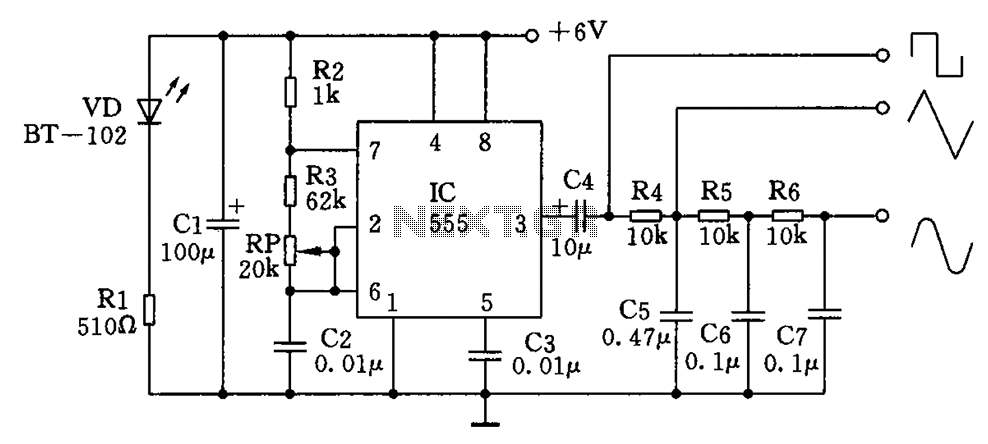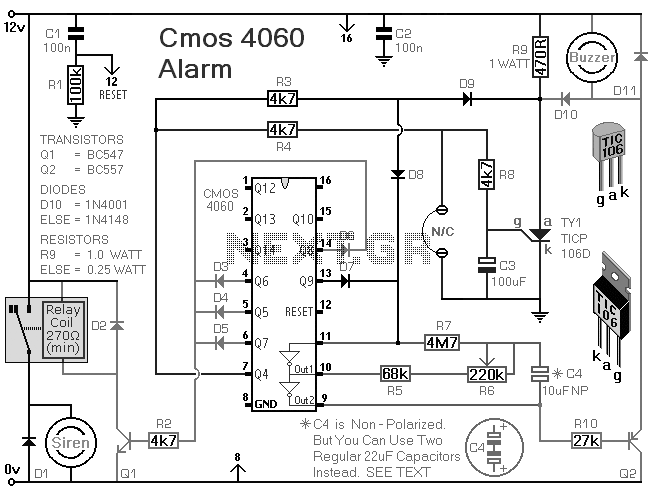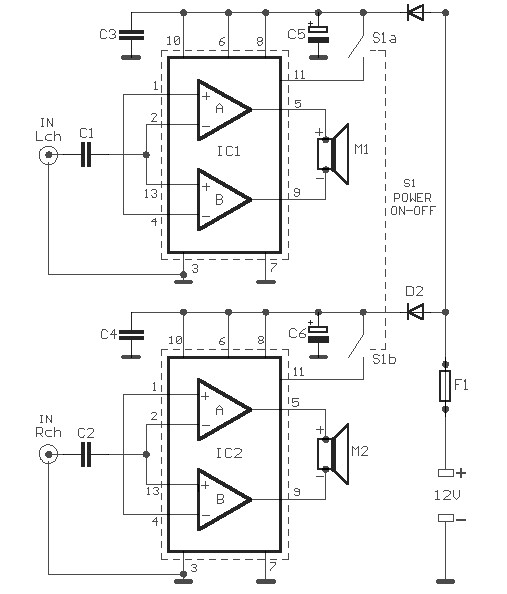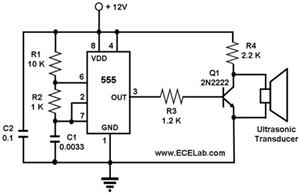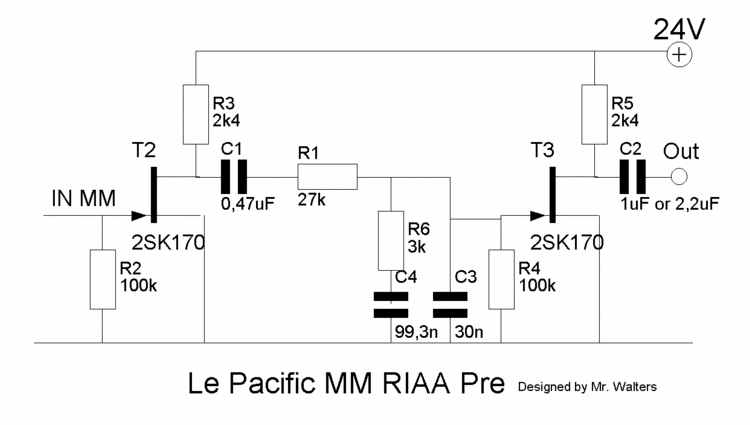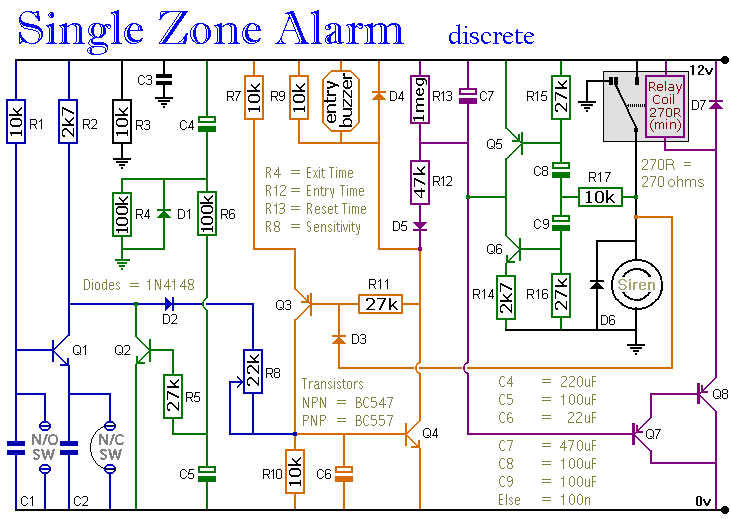
Schematic Diagram Anti Theft Car wireless alarm
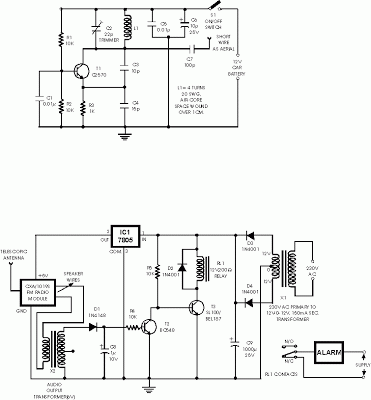
This is an anti-theft alarm with wireless connectivity, referred to as the Anti-Theft Car Wireless Alarm. The FM radio-controlled anti-theft alarm can be utilized with any vehicle that operates on a 6 to 12-volt DC supply system. The mini VHF FM transmitter is installed in the vehicle when parked at night, either in a car porch or parking lot. The receiver unit, which incorporates the CXA1019, a single IC-based FM radio module that is readily available at a reasonable price, is kept inside the vehicle. The receiver is tuned to the transmitter's frequency. When the transmitter is active and the FM radio receiver is receiving signals, there is no hissing noise at the output of the receiver, which prevents transistor T2 (BC548) from conducting. Consequently, the relay driver transistor T3 receives its forward base bias through a 10k resistor (R5), causing the relay to energize. If an intruder attempts to drive the car away, breaking the radio link between the transmitter and receiver, the FM radio module generates a hissing noise. This hissing AC signal is coupled to the relay switching circuit via an audio transformer. The AC signals are then rectified and filtered by diode D1 and capacitor C8, producing a positive DC voltage that provides forward bias to transistor T2. As a result, transistor T2 conducts, pulling the base of relay driver transistor T3 to ground level, deactivating the relay and activating the alarm connected through the normally closed (N/C) contacts of the relay. Even if the intruder disconnects the transmitter from the battery, the remote alarm remains activated, as the absence of the signal continues to produce hissing noise at the receiver's output. Therefore, the burglar alarm is foolproof and highly reliable.
The Anti-Theft Car Wireless Alarm system is designed to enhance vehicle security through a wireless FM communication protocol. The system consists of a transmitter and a receiver, where the transmitter is installed within the vehicle and operates within a voltage range of 6 to 12 volts DC. The transmitter continuously sends signals to the receiver, which is tuned to the same frequency, ensuring seamless communication between the two components.
The use of the CXA1019 FM radio module as the receiver allows for a compact and cost-effective solution. The absence of noise at the output of the receiver when the transmitter is active indicates a stable connection, allowing for the normal operation of the relay driver circuit. The relay driver, utilizing a BC548 transistor (T2), is pivotal in controlling the relay operation. When the system is in a secure state, the relay remains energized, preventing the alarm from sounding.
In the event of a security breach, such as an unauthorized attempt to move the vehicle, the disruption of the radio link triggers the generation of hissing noise by the FM radio module. This noise is critical as it activates the relay switching circuit, which is facilitated by an audio transformer that couples the AC signals. The rectification and filtering process performed by diode D1 and capacitor C8 converts the AC signals into a usable DC voltage, which in turn biases transistor T2 into conduction. This action effectively grounds the base of transistor T3, causing the relay to deactivate and subsequently triggering the alarm system.
The design incorporates fail-safes, ensuring that even if the transmitter is disconnected from its power source, the receiver continues to produce the hissing signal due to the lack of a carrier frequency. This feature guarantees that the alarm remains active, providing a robust defense against tampering. Overall, the Anti-Theft Car Wireless Alarm system is a reliable solution for vehicle security, combining simplicity with effective performance.This is anti theft alarm with wireless connectivity, called Anti Theft Car wireless alarm The FM radio-controlled anti- theft alarm can be used with any vehicle having 6- to 12-volt DC supply system. The mini VHF, FM transmitter is fitted in the vehicle at night when it is parked in the car porch or car park.
The receiver unit with CXA1019, a sing le IC-based FM radio module, which is freely available in the market at reasonable rate, is kept inside. Receiver is tuned to the transmitter`s frequency. When the transmitter is on and the signals are being received by FM radio receiver, no hissing noise is available at the output of receiver.
Thus transistor T2 (BC548) does not conduct. This results in the relay driver transistor T3 getting its forward base bias via 10k resistor R5 and the relay gets energised. When an intruder tries to drive the car and takes it a few metres away from the car porch, the radio link between the car (transmitter) and alarm (receiver) is broken.
As a result FM radio module gene-rates hissing noise. Hissing AC signals are coupled to relay switching circ- uit via audio transformer. These AC signals are rectified and filtered by diode D1 and capacitor C8, and the resulting positive DC voltage provides a forward bias to transistor T2. Thus transistor T2 conducts, and it pulls the base of relay driver transistor T3 to ground level. The relay thus gets de-activated and the alarm connected via N/C contacts of relay is switched on. If, by chance, the intruder finds out about the wireless alarm and disconnects the transmitter from battery, still remote alarm remains activated because in the absence of signal, the receiver continues to produce hissing noise at its output.
So the burglar alarm is fool-proof and highly reliable. 🔗 External reference
The Anti-Theft Car Wireless Alarm system is designed to enhance vehicle security through a wireless FM communication protocol. The system consists of a transmitter and a receiver, where the transmitter is installed within the vehicle and operates within a voltage range of 6 to 12 volts DC. The transmitter continuously sends signals to the receiver, which is tuned to the same frequency, ensuring seamless communication between the two components.
The use of the CXA1019 FM radio module as the receiver allows for a compact and cost-effective solution. The absence of noise at the output of the receiver when the transmitter is active indicates a stable connection, allowing for the normal operation of the relay driver circuit. The relay driver, utilizing a BC548 transistor (T2), is pivotal in controlling the relay operation. When the system is in a secure state, the relay remains energized, preventing the alarm from sounding.
In the event of a security breach, such as an unauthorized attempt to move the vehicle, the disruption of the radio link triggers the generation of hissing noise by the FM radio module. This noise is critical as it activates the relay switching circuit, which is facilitated by an audio transformer that couples the AC signals. The rectification and filtering process performed by diode D1 and capacitor C8 converts the AC signals into a usable DC voltage, which in turn biases transistor T2 into conduction. This action effectively grounds the base of transistor T3, causing the relay to deactivate and subsequently triggering the alarm system.
The design incorporates fail-safes, ensuring that even if the transmitter is disconnected from its power source, the receiver continues to produce the hissing signal due to the lack of a carrier frequency. This feature guarantees that the alarm remains active, providing a robust defense against tampering. Overall, the Anti-Theft Car Wireless Alarm system is a reliable solution for vehicle security, combining simplicity with effective performance.This is anti theft alarm with wireless connectivity, called Anti Theft Car wireless alarm The FM radio-controlled anti- theft alarm can be used with any vehicle having 6- to 12-volt DC supply system. The mini VHF, FM transmitter is fitted in the vehicle at night when it is parked in the car porch or car park.
The receiver unit with CXA1019, a sing le IC-based FM radio module, which is freely available in the market at reasonable rate, is kept inside. Receiver is tuned to the transmitter`s frequency. When the transmitter is on and the signals are being received by FM radio receiver, no hissing noise is available at the output of receiver.
Thus transistor T2 (BC548) does not conduct. This results in the relay driver transistor T3 getting its forward base bias via 10k resistor R5 and the relay gets energised. When an intruder tries to drive the car and takes it a few metres away from the car porch, the radio link between the car (transmitter) and alarm (receiver) is broken.
As a result FM radio module gene-rates hissing noise. Hissing AC signals are coupled to relay switching circ- uit via audio transformer. These AC signals are rectified and filtered by diode D1 and capacitor C8, and the resulting positive DC voltage provides a forward bias to transistor T2. Thus transistor T2 conducts, and it pulls the base of relay driver transistor T3 to ground level. The relay thus gets de-activated and the alarm connected via N/C contacts of relay is switched on. If, by chance, the intruder finds out about the wireless alarm and disconnects the transmitter from battery, still remote alarm remains activated because in the absence of signal, the receiver continues to produce hissing noise at its output.
So the burglar alarm is fool-proof and highly reliable. 🔗 External reference
